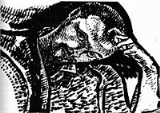
. His highly individual style was influenced by movements in art that included expressionism
, cubism
, and surrealism
. He was, as well, a student of orientalism
. Klee was a natural draftsman who experimented with and eventually mastered colour theory, and wrote extensively about it; his lectures Writings on Form and Design Theory (Schriften zur Form und Gestaltungslehre), published in English as the Paul Klee Notebooks
, are considered so important for modern art that they are compared to the importance that Leonardo da Vinci
's A Treatise on Painting
had for Renaissance
.
Art should be like a holiday: something to give a man the opportunity to see things differently and to change his point of view.![]()
My mirror probes down to the heart. I write words on the forehead and around the corners of the mouth. My human faces are truer than the real ones. ![]()
The main thing now is not to paint precociously but to be, or at least become, an individual. The art of mastering life is the prerequisite for all further forms of expression, whether they are paintings, sculptures, tragedies, or musical compositions.![]()
When looking at any significant work of art, remember that a more significant one probably has had to be sacrificed. ![]()
The beautiful, which is perhaps inseparable from art, is not after all tied to the subject, but to the pictorial representation. In this way and in no other does art overcome the ugly without avoiding it.![]()
To emphasize only the beautiful seems to me to be like a mathematical system that only concerns itself with positive numbers.![]()
He has found his style, when he cannot do otherwise, i.e., cannot do something else.![]()
Nature can afford to be prodigal in everything, the artist must be frugal down to the last detail.Nature is garrulous to the point of confusion, let the artist be truly taciturn.![]()
All the things an artist must be: poet, explorer of nature, philosopher!![]()

